April 1 no fool’s day for Swapo
STAFF REPORTER
WINDHOEK
The former chief of staff of Swapo’s armed wing PLAN, Charles Namoloh, says it is time the nation recognised the historical importance of 1 April, which carries significant history for the country’s liberation struggle.
Speaking to Namibian Sun’s The Evening Review Show yesterday, Namoloh said on this day in 1983, PLAN commander Peter Nanyemba died in a car accident in Lubango in Angola's Huila Province, when his car collided with a petrol tanker.
His remains were repatriated from Angola 31 years after his death and reburied at Windhoek’s Heroes’ Acre. Nanyemba was considered one of the best soldiers the country’s liberation struggle had.
“He was a very talented and visionary man,” said Namoloh, who until a week ago was minister of safety and security.
“He was the architect of what PLAN came to be, a force to be reckoned with on the African continent and globally.
“He put up good structures that allowed us to confront the best defence force in Africa at the time, which [included] the apartheid South African army.”
Resolution 435
Six years later, on the same day in 1989, PLAN combatants returning to Namibia during the implementation of United Nations Resolution 435 clashed with police and military forces of the apartheid regime, a battle that eventually lasted for about nine days.
The death toll at the end of the bloody confrontation stood at 253 PLAN fighters and 26 policemen and SADF/SWATF members.
“There are mass graves in the north emanating from that fight, such as one at Ondeshifiilwa,” recalls Namoloh, a retired major-general of the Namibian Defence Force (NDF) and former defence minister.
“This day cannot just pass without being mentioned. Many of the comrades who perished in that battle were the survivors of the actual war.”
Namoloh says just as 26 August 1966 is recognised as the day the first bullet was fired to start the armed liberation struggle, 1 April is equally important as it signifies the last bullets shot to end the war.
WINDHOEK
The former chief of staff of Swapo’s armed wing PLAN, Charles Namoloh, says it is time the nation recognised the historical importance of 1 April, which carries significant history for the country’s liberation struggle.
Speaking to Namibian Sun’s The Evening Review Show yesterday, Namoloh said on this day in 1983, PLAN commander Peter Nanyemba died in a car accident in Lubango in Angola's Huila Province, when his car collided with a petrol tanker.
His remains were repatriated from Angola 31 years after his death and reburied at Windhoek’s Heroes’ Acre. Nanyemba was considered one of the best soldiers the country’s liberation struggle had.
“He was a very talented and visionary man,” said Namoloh, who until a week ago was minister of safety and security.
“He was the architect of what PLAN came to be, a force to be reckoned with on the African continent and globally.
“He put up good structures that allowed us to confront the best defence force in Africa at the time, which [included] the apartheid South African army.”
Resolution 435
Six years later, on the same day in 1989, PLAN combatants returning to Namibia during the implementation of United Nations Resolution 435 clashed with police and military forces of the apartheid regime, a battle that eventually lasted for about nine days.
The death toll at the end of the bloody confrontation stood at 253 PLAN fighters and 26 policemen and SADF/SWATF members.
“There are mass graves in the north emanating from that fight, such as one at Ondeshifiilwa,” recalls Namoloh, a retired major-general of the Namibian Defence Force (NDF) and former defence minister.
“This day cannot just pass without being mentioned. Many of the comrades who perished in that battle were the survivors of the actual war.”
Namoloh says just as 26 August 1966 is recognised as the day the first bullet was fired to start the armed liberation struggle, 1 April is equally important as it signifies the last bullets shot to end the war.




Comments
Namibian Sun
No comments have been left on this article